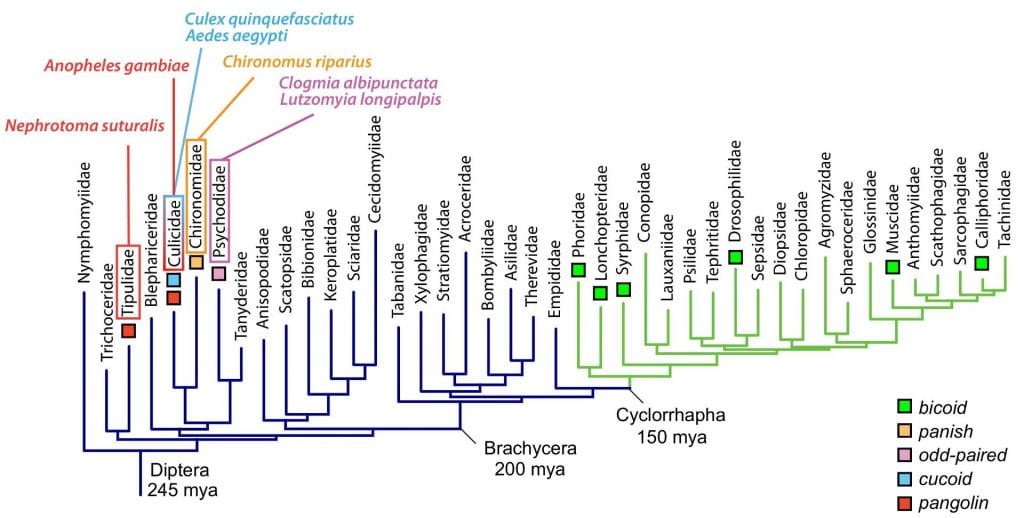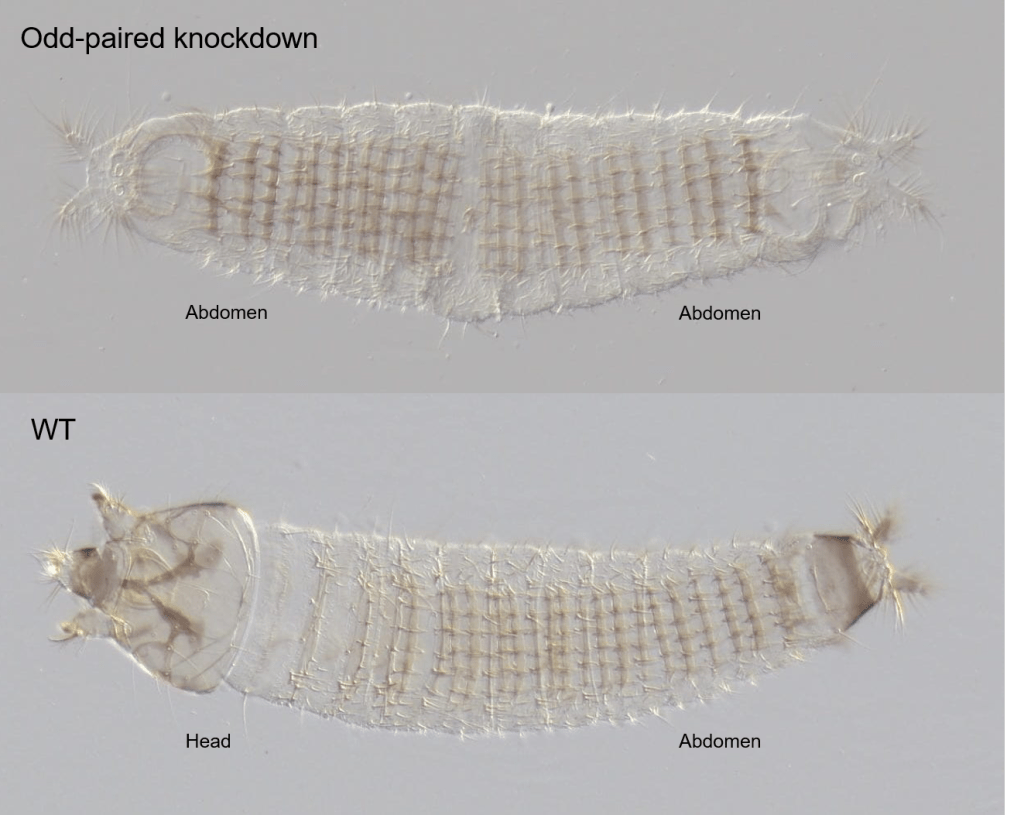Embryonic Axis Determinants in Flies, Midges, and Mosquitoes
We discovered that symmetry-breaking anterior axis determinants vary greatly between species of the insect order Diptera (true flies). These factors are expressed in long-range concentration gradients and serve as global pattern organizers with many direct target genes. In D. melanogaster, specification of the primary body axis relies in large part on the homeodomain transcription factor Bicoid, but other fly species use unrelated proteins for the same purpose and lack the bicoid gene altogether. Why anterior determinants differ between species is unknown. We use the evolution axis determinants in dipteran embryos as a model to address the general question of what holds developmental gene networks together over many million years and under which conditions they undergo radical change.

Figure: The phylogenetic tree indicates the occurrence of anterior axis determinants in dipteran families. The phylogeny is based on Wiegmann et. al., 2011, PNAS 108: 5690-5695.

Figure: First instar cuticles of Clogmia albipunctata in dorsal view with anterior to the left. Top: A double abdomen following knockdown of maternal odd-paired transcript. Bottom: a wild-type cuticle (Yoon et al. 2019).
Publications
- Twenty-seven ZAD-ZNF genes of Drosophila melanogaster are orthologous to the embryo polarity determining mosquito gene cucoid. PLoS One. 2023 Jan 3;18(1):e0274716. doi: 10.1371/journal.pone.0274716. eCollection 2023. PMID: 36595500
- Evolution and loss of ß-catenin and TCF-dependent axis specification in insects. Curr Opin Insect Sci. 2022 Apr;50:100877. doi: 10.1016/j.cois.2022.100877. Epub 2022 Jan 31. PMID: 35104659
- Embryo polarity in moth flies and mosquitoes relies on distinct old genes with localized transcript isoforms. Yoon Y, Klomp J, Martin-Martin I, Criscione F, Calvo E, Ribeiro J, Schmidt-Ott U. Elife. 2019 Oct 8;8. pii: e46711. doi: 10.7554/eLife.46711. PMID:31591963
- Ancient mechanisms for the evolution of the bicoid homeodomain’s function in fly development. Liu Q, Onal P, Datta RR, Rogers JM, Schmidt-Ott U, Bulyk ML, Small S, Thornton JW. eLife. 2018; 7.PMID:30298815, PMCID:PMC6177261
- Embryo development. A cysteine-clamp gene drives embryo polarity in the midge Chironomus. Klomp J, Athy D, Kwan CW, Bloch NI, Sandmann T, Lemke S, Schmidt-Ott U. Science. 2015; 348(6238):1040-2. PMID:25953821, PMCID:PMC4449817
- Maternal activation of gap genes in the hover fly Episyrphus. Lemke S, Busch SE, Antonopoulos DA, Meyer F, Domanus MH, Schmidt-Ott U. Development. 2010; 137(10):1709-19. PMID:20430746
- Expression and regulation of caudal in the lower cyclorrhaphan fly Megaselia. Stauber M, Lemke S, Schmidt-Ott U. Development Genes and Evolution. 2008; 218(2):81-7. PMID:18214532, PMCID:PMC2757626
- Bicoid occurrence and Bicoid-dependent hunchback regulation in lower cyclorrhaphan flies. Lemke S, Stauber M, Shaw PJ, Rafiqi AM, Prell A, Schmidt-Ott U. Evolution & Development. 2008; 10(4):413-20. PMID:18638318
- A single Hox3 gene with composite bicoid and zerknullt expression characteristics in non-Cyclorrhaphan flies. Stauber M, Prell A, Schmidt-Ott U. Proceedings of the National Academy of Sciences of the United States of America. 2002; 99(1):274-9. PMID:11773616, PMCID:PMC117551
- Function of bicoid and hunchback homologs in the basal cyclorrhaphan fly Megaselia (Phoridae). Stauber M, Taubert H, Schmidt-Ott U. Proceedings of the National Academy of Sciences of the United States of America. 2000; 97(20):10844-9. PMID:10995461, PMCID:PMC27111
- The anterior determinant bicoid of Drosophila is a derived Hox class 3 gene. Stauber M, Jäckle H, Schmidt-Ott U. Proceedings of the National Academy of Sciences of the United States of America. 1999; 96(7):3786-9. PMID:10097115, PMCID:PMC22372
- RNA binding and translational suppression by bicoid. Rivera-Pomar R, Niessing D, Schmidt-Ott U, Gehring WJ, Jäckle H. Nature. 1996; 379(6567):746-9. PMID:8602224
